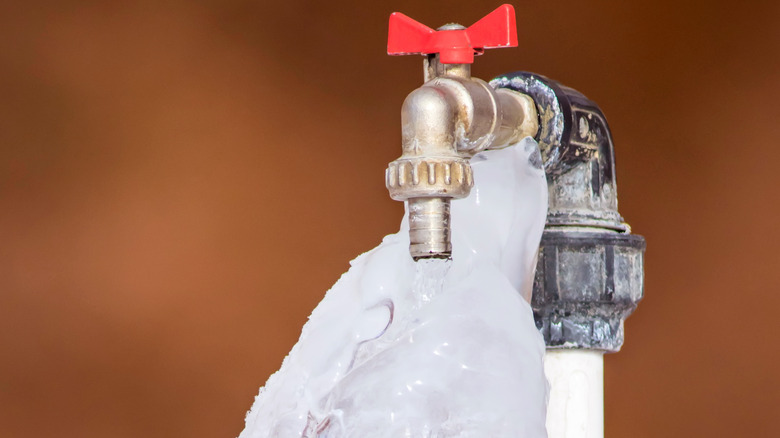Preventing Frozen Plumbing: Effective Tips for Winter
Preventing Frozen Plumbing: Effective Tips for Winter
Blog Article
What're your insights and beliefs about 6 Ways to Prevent Frozen Pipes?

Cold weather can ruin your pipes, specifically by freezing pipelines. Here's just how to avoid it from happening and what to do if it does.
Intro
As temperatures decline, the risk of icy pipes increases, possibly resulting in pricey repair work and water damages. Understanding exactly how to stop frozen pipes is critical for home owners in cold climates.
Recognizing Icy Pipes
What triggers pipelines to ice up?
Pipelines ice up when subjected to temperature levels listed below 32 ° F (0 ° C) for extended periods. As water inside the pipes freezes, it expands, putting pressure on the pipe walls and potentially creating them to break.
Threats and problems
Icy pipes can cause water disturbances, home damage, and pricey repairs. Ruptured pipelines can flood homes and cause substantial structural damages.
Indications of Frozen Water Lines
Recognizing icy pipes early can avoid them from bursting.
Exactly how to identify icy pipelines
Search for decreased water circulation from faucets, unusual smells or noises from pipelines, and noticeable frost on subjected pipes.
Avoidance Tips
Insulating at risk pipes
Cover pipes in insulation sleeves or utilize warmth tape to shield them from freezing temperatures. Concentrate on pipes in unheated or external areas of the home.
Home heating techniques
Keep indoor spaces adequately heated up, specifically areas with plumbing. Open up closet doors to allow warm air to flow around pipelines under sinks.
Protecting Outdoor Plumbing
Garden hose pipes and outside taps
Detach and drain pipes yard tubes prior to winter. Mount frost-proof spigots or cover outside taps with protected caps.
What to Do If Your Pipelines Freeze
Immediate activities to take
If you think icy pipelines, keep faucets available to soothe pressure as the ice thaws. Utilize a hairdryer or towels soaked in warm water to thaw pipes slowly.
Long-Term Solutions
Architectural changes
Consider rerouting pipes away from exterior walls or unheated locations. Include extra insulation to attic rooms, basements, and crawl spaces.
Updating insulation
Invest in high-grade insulation for pipes, attic rooms, and walls. Correct insulation aids keep regular temperatures and minimizes the risk of icy pipes.
Conclusion
Preventing frozen pipes needs aggressive steps and quick responses. By comprehending the causes, signs, and safety nets, home owners can secure their plumbing throughout cold weather.
6 Proven Ways to Prevent Frozen Pipes and Protect Your Home
Disconnect and Drain Garden Hoses
Before winter arrives, start by disconnecting your garden hoses and draining any remaining water. Close the shut-off valves that supply outdoor hose bibs and leave the outdoor faucet open to allow any residual water to drain. For extra protection, consider using faucet covers throughout the colder months. It’s also important to drain water from any sprinkler supply lines following the manufacturer’s directions.
Insulate Exposed Pipes
Insulating your pipes is an effective way to prevent freezing. Pipe insulation is readily available at home improvement stores and is relatively inexpensive. Pay close attention to pipes in unheated areas such as the attic, basement, crawl spaces, or garage. Apply foam insulation generously to create a buffer against the cold. You can also wrap your pipes in heat tape or thermostat-controlled heat cables for added warmth.
Seal Air Leaks
Inspect your home for any cracks or openings that could let in cold air. Seal any holes around the piping in interior or exterior walls, as well as the sill plates where your home rests on its foundation. Additionally, make sure to keep your garage door closed unless you’re entering or exiting. Leaving it open creates a significant air leak that can lead to frozen pipes.
Allow Warm Air Circulation
During cold snaps, it’s essential to allow warm air to circulate evenly throughout your home. Leave interior doors ajar to promote better airflow. Open kitchen and bathroom cabinets to help distribute heat consistently around the rooms. If you have small children or pets, be sure to remove any household chemicals or potentially harmful cleaners from open cabinets for safety.
Let Faucets Drip
A small trickle of water can make a big difference in preventing ice formation inside your pipes. When temperatures drop significantly, start a drip of water from all faucets served by exposed pipes. This continuous flow helps prevent the water from freezing. Additionally, running a few faucets slightly can relieve pressure inside the pipes, reducing the chances of a rupture if the water inside does freeze.
https://choateshvac.com/6-proven-ways-to-prevent-frozen-pipes-and-protect-your-home/

We had been made aware of that report on How To Avoid Freezing Pipes through an associate on another blog. Don't hesitate to take the time to distribute this blog if you enjoyed reading it. Thank you so much for taking the time to read it.
Go Services Report this page